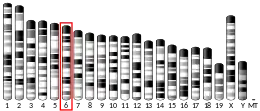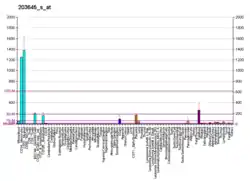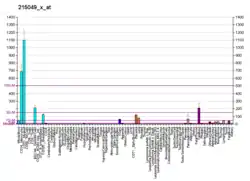CD163
CD163 (Cluster of Differentiation 163) is a protein that in humans is encoded by the CD163 gene.[5] CD163 is the high affinity scavenger receptor for the hemoglobin-haptoglobin complex[6] and in the absence of haptoglobin - with lower affinity - for hemoglobin alone.[7] It also is a marker of cells from the monocyte/macrophage lineage.[8] CD163 functions as innate immune sensor for gram-positive and gram-negative bacteria.[9][10] The receptor was discovered in 1987.[11]
| CD163 | |||||||||||||||||||||||||||||||||||||||||||||||||||
|---|---|---|---|---|---|---|---|---|---|---|---|---|---|---|---|---|---|---|---|---|---|---|---|---|---|---|---|---|---|---|---|---|---|---|---|---|---|---|---|---|---|---|---|---|---|---|---|---|---|---|---|
| Identifiers | |||||||||||||||||||||||||||||||||||||||||||||||||||
| Aliases | CD163, M130, MM130, SCARI1, CD163 molecule | ||||||||||||||||||||||||||||||||||||||||||||||||||
| External IDs | OMIM: 605545 MGI: 2135946 HomoloGene: 128811 GeneCards: CD163 | ||||||||||||||||||||||||||||||||||||||||||||||||||
| |||||||||||||||||||||||||||||||||||||||||||||||||||
| |||||||||||||||||||||||||||||||||||||||||||||||||||
| |||||||||||||||||||||||||||||||||||||||||||||||||||
| |||||||||||||||||||||||||||||||||||||||||||||||||||
| |||||||||||||||||||||||||||||||||||||||||||||||||||
| Wikidata | |||||||||||||||||||||||||||||||||||||||||||||||||||
| |||||||||||||||||||||||||||||||||||||||||||||||||||
Structure
The molecular size is 130 kDa. The receptor belongs to the scavenger receptor cysteine rich family type B and consists of a 1048 amino acid residues extracellular domain, a single transmembrane segment and a cytoplasmic tail with several splice variants.
Clinical significance
A soluble form of the receptor exists in plasma, and cerebrospinal fluid.,[12] commonly denoted sCD163. It is generated by ectodomain shedding of the membrane bound receptor, which may represent a form of modulation of CD163 function.[13] sCD163 shedding occurs as a result of enzymatic cleavage by ADAM17.[14] sCD163 is upregulated in a large range of inflammatory diseases including liver cirrhosis,[15] type 2 diabetes, macrophage activation syndrome, Gaucher's disease, sepsis, HIV infection, rheumatoid arthritis and Hodgkin Lymphoma.[16][17] sCD163 is also upregulated in cerebrospinal fluid after subarachnoid haemorrhage.[12] CD163 has recently been identified as expressed on neurons in the CNS following hemorrhage, although the significance of this is unclear.[18][19][20] The excretion of soluble CD163 into the urine is tightly associated with the presence of active glomerulonephritis in systemic lupus erythematosus and ANCA vasculitis and can be used to track response to therapy. [21]
Differences between mouse and human
Differences between mice and humans in CD163 biology are important to note since preclinical studies are frequently conducted in mice. sCD163 shedding occurs in humans but not mice, due to the emergence of an Arg-Ser-Ser-Arg sequence in humans, essential for enzymatic cleavage by ADAM17.[22] Human CD163, but not mouse CD163, exhibits a strikingly higher affinity to hemoglobin-haptoglobin complex compared to hemoglobin alone.[23]
Animal studies
Pigs with a section of the CD163 gene removed showed complete resistance to the virus that causes Porcine Reproductive and Respiratory Syndrome.[24]
See also
References
- GRCh38: Ensembl release 89: ENSG00000177575 - Ensembl, May 2017
- GRCm38: Ensembl release 89: ENSMUSG00000008845 - Ensembl, May 2017
- "Human PubMed Reference:". National Center for Biotechnology Information, U.S. National Library of Medicine.
- "Mouse PubMed Reference:". National Center for Biotechnology Information, U.S. National Library of Medicine.
- "Entrez Gene: CD163 CD163 molecule".
- Kristiansen M, Graversen JH, Jacobsen C, Sonne O, Hoffman HJ, Law SK, Moestrup SK (January 2001). "Identification of the haemoglobin scavenger receptor". Nature. 409 (6817): 198–201. Bibcode:2001Natur.409..198K. doi:10.1038/35051594. PMID 11196644. S2CID 205012693.
- Schaer DJ, Schaer CA, Buehler PW, Boykins RA, Schoedon G, Alayash AI, Schaffner A (January 2006). "CD163 is the macrophage scavenger receptor for native and chemically modified hemoglobins in the absence of haptoglobin". Blood. 107 (1): 373–80. doi:10.1182/blood-2005-03-1014. PMID 16189277.
- Lau SK, Chu PG, Weiss LM (November 2004). "CD163: a specific marker of macrophages in paraffin-embedded tissue samples". American Journal of Clinical Pathology. 122 (5): 794–801. doi:10.1309/QHD6YFN81KQXUUH6. PMID 15491976.
- Fabriek BO, van Bruggen R, Deng DM, Ligtenberg AJ, Nazmi K, Schornagel K, Vloet RP, Dijkstra CD, van den Berg TK (January 2009). "The macrophage scavenger receptor CD163 functions as an innate immune sensor for bacteria" (PDF). Blood. 113 (4): 887–92. doi:10.1182/blood-2008-07-167064. PMID 18849484. S2CID 4811741.
- Van Gorp H, Delputte PL, Nauwynck HJ (April 2010). "Scavenger receptor CD163, a Jack-of-all-trades and potential target for cell-directed therapy". Molecular Immunology. 47 (7–8): 1650–60. doi:10.1016/j.molimm.2010.02.008. PMID 20299103.
- Onofre G, Kolácková M, Jankovicová K, Krejsek J (2009). "Scavenger receptor CD163 and its biological functions". Acta Medica. 52 (2): 57–61. PMID 19777868.
- Galea J, Cruickshank G, Teeling JL, Boche D, Garland P, Perry VH, Galea I (June 2012). "The intrathecal CD163-haptoglobin-hemoglobin scavenging system in subarachnoid hemorrhage". Journal of Neurochemistry. 121 (5): 785–92. doi:10.1111/j.1471-4159.2012.07716.x. PMC 3412209. PMID 22380637.
- Droste A, Sorg C, Högger P (March 1999). "Shedding of CD163, a novel regulatory mechanism for a member of the scavenger receptor cysteine-rich family". Biochemical and Biophysical Research Communications. 256 (1): 110–3. doi:10.1006/bbrc.1999.0294. PMID 10066432.
- Etzerodt A, Maniecki MB, Møller K, Møller HJ, Moestrup SK (December 2010). "Tumor necrosis factor α-converting enzyme (TACE/ADAM17) mediates ectodomain shedding of the scavenger receptor CD163". Journal of Leukocyte Biology. 88 (6): 1201–5. doi:10.1189/jlb.0410235. PMID 20807704. S2CID 38771947.
- Tornai, Tamas; Vitalis, Zsuzsanna; Sipeki, Nora; Dinya, Tamas; Tornai, David; Antal‐Szalmas, Peter; Karanyi, Zsolt; Tornai, Istvan; Papp, Maria (2016). "Macrophage activation marker, soluble CD163, is an independent predictor of short-term mortality in patients with cirrhosis and bacterial infection". Liver International. 36 (11): 1628–1638. doi:10.1111/liv.13133. hdl:2437/223046. ISSN 1478-3231. PMID 27031405. S2CID 206174528.
- Jones K, Vari F, Keane C, Crooks P, Nourse JP, Seymour LA, Gottlieb D, Ritchie D, Gill D, Gandhi MK (February 2013). "Serum CD163 and TARC as disease response biomarkers in classical Hodgkin lymphoma". Clinical Cancer Research. 19 (3): 731–42. doi:10.1158/1078-0432.CCR-12-2693. PMID 23224400.
- Møller HJ (February 2012). "Soluble CD163". Scandinavian Journal of Clinical and Laboratory Investigation. 72 (1): 1–13. doi:10.3109/00365513.2011.626868. PMID 22060747. S2CID 42546891.
- Garton TP, He Y, Garton HJ, Keep RF, Xi G, Strahle JM (15 March 2016). "Hemoglobin-induced neuronal degeneration in the hippocampnus after neonatal intraventricular hemorrhage". Brain Research. 1635: 86–94. doi:10.1016/j.brainres.2015.12.060. PMC 4801173. PMID 26772987.
- Garton T, Keep RF, Hua Y, Xi G (April 6, 2017). "CD163, a Hemoglobin/Haptoglobin Scavenger Receptor, After Intracerebral Hemorrhage: Functions in Microglia/Macrophages Versus Neurons". Translational Stroke Research. 8 (6): 612–616. doi:10.1007/s12975-017-0535-5. PMID 28386733.
- Liu R, Cao S, Hua Y, Keep RF, Huang Y, Xi G (May 1, 2017). "CD163 Expression in Neurons After Experimental Intracerebral Hemorrhage". Stroke. 48 (5): 1369–1375. doi:10.1161/STROKEAHA.117.016850. PMC 5404936. PMID 28360115.
- O'Reilly, Vincent (September 2016). "Urinary Soluble CD163 in Active Renal Vasculitis". J Am Soc Nephrol. 27 (9): 2906–2916. doi:10.1681/ASN.2015050511. PMC 5004645. PMID 26940094.
- Etzerodt A, Rasmussen MR, Svendsen P, Chalaris A, Schwarz J, Galea I, Møller HJ, Moestrup SK (January 2014). "Structural basis for inflammation-driven shedding of CD163 ectodomain and tumor necrosis factor-α in macrophages". The Journal of Biological Chemistry. 289 (2): 778–88. doi:10.1074/jbc.m113.520213. PMC 3887204. PMID 24275664.
- Etzerodt A, Kjolby M, Nielsen MJ, Maniecki M, Svendsen P, Moestrup SK (June 2013). "Plasma clearance of hemoglobin and haptoglobin in mice and effect of CD163 gene targeting disruption". Antioxidants & Redox Signaling. 18 (17): 2254–63. doi:10.1089/ars.2012.4605. PMID 22793784.
- Burkard C, Lillico SG, Reid E, Jackson B, Mileham AJ, Ait-Ali T, Whitelaw CB, Archibald AL (February 2017). "Precision engineering for PRRSV resistance in pigs: Macrophages from genome edited pigs lacking CD163 SRCR5 domain are fully resistant to both PRRSV genotypes while maintaining biological function". PLOS Pathogens. 13 (2): e1006206. doi:10.1371/journal.ppat.1006206. PMC 5322883. PMID 28231264.
- Ritter M, Buechler C, Kapinsky M, Schmitz G (April 2001). "Interaction of CD163 with the regulatory subunit of casein kinase II (CKII) and dependence of CD163 signaling on CKII and protein kinase C". European Journal of Immunology. 31 (4): 999–1009. doi:10.1002/1521-4141(200104)31:4<999::AID-IMMU999>3.0.CO;2-R. PMID 11298324.
Further reading
- Ren H, Han R, Chen X, Liu X, Wan J, Wang L, Yang X, Wang J (May 2020). "Potential therapeutic targets for intracerebral hemorrhage-associated inflammation: An update". J Cereb Blood Flow Metab. 40 (9): 1752–1768. doi:10.1177/0271678X20923551. PMC 7446569. PMID 32423330.
- Graversen JH, Madsen M, Moestrup SK (April 2002). "CD163: a signal receptor scavenging haptoglobin-hemoglobin complexes from plasma". The International Journal of Biochemistry & Cell Biology. 34 (4): 309–14. doi:10.1016/S1357-2725(01)00144-3. PMID 11854028.
- Madsen M, Graversen JH, Moestrup SK (2002). "Haptoglobin and CD163: captor and receptor gating hemoglobin to macrophage lysosomes". Redox Report. 6 (6): 386–8. doi:10.1179/135100001101536490. PMID 11865982.
- Moestrup SK, Møller HJ (2005). "CD163: a regulated hemoglobin scavenger receptor with a role in the anti-inflammatory response". Annals of Medicine. 36 (5): 347–54. doi:10.1080/07853890410033171. PMID 15478309. S2CID 32420894.
- Maruyama K, Sugano S (January 1994). "Oligo-capping: a simple method to replace the cap structure of eukaryotic mRNAs with oligoribonucleotides". Gene. 138 (1–2): 171–4. doi:10.1016/0378-1119(94)90802-8. PMID 8125298.
- Law SK, Micklem KJ, Shaw JM, Zhang XP, Dong Y, Willis AC, Mason DY (September 1993). "A new macrophage differentiation antigen which is a member of the scavenger receptor superfamily". European Journal of Immunology. 23 (9): 2320–5. doi:10.1002/eji.1830230940. PMID 8370408. S2CID 39770686.
- Suzuki Y, Yoshitomo-Nakagawa K, Maruyama K, Suyama A, Sugano S (October 1997). "Construction and characterization of a full length-enriched and a 5'-end-enriched cDNA library". Gene. 200 (1–2): 149–56. doi:10.1016/S0378-1119(97)00411-3. PMID 9373149.
- Droste A, Sorg C, Högger P (March 1999). "Shedding of CD163, a novel regulatory mechanism for a member of the scavenger receptor cysteine-rich family". Biochemical and Biophysical Research Communications. 256 (1): 110–3. doi:10.1006/bbrc.1999.0294. PMID 10066432.
- Ritter M, Buechler C, Langmann T, Schmitz G (July 1999). "Genomic organization and chromosomal localization of the human CD163 (M130) gene: a member of the scavenger receptor cysteine-rich superfamily". Biochemical and Biophysical Research Communications. 260 (2): 466–74. doi:10.1006/bbrc.1999.0866. PMID 10403791.
- Van den Heuvel MM, Tensen CP, van As JH, Van den Berg TK, Fluitsma DM, Dijkstra CD, Döpp EA, Droste A, Van Gaalen FA, Sorg C, Högger P, Beelen RH (November 1999). "Regulation of CD 163 on human macrophages: cross-linking of CD163 induces signaling and activation". Journal of Leukocyte Biology. 66 (5): 858–66. doi:10.1002/jlb.66.5.858. PMID 10577520. S2CID 24504516.
- Buechler C, Ritter M, Orsó E, Langmann T, Klucken J, Schmitz G (January 2000). "Regulation of scavenger receptor CD163 expression in human monocytes and macrophages by pro- and antiinflammatory stimuli". Journal of Leukocyte Biology. 67 (1): 97–103. doi:10.1002/jlb.67.1.97. PMID 10648003. S2CID 9117014.
- Stover CM, Schleypen J, Grønlund J, Speicher MR, Schwaeble WJ, Holmskov U (2001). "Assignment of CD163B, the gene encoding M160, a novel scavenger receptor, to human chromosome 12p13.3 by in situ hybridization and somatic cell hybrid analysis". Cytogenetics and Cell Genetics. 90 (3–4): 246–7. doi:10.1159/000056781. PMID 11124526. S2CID 44704901.
- Kristiansen M, Graversen JH, Jacobsen C, Sonne O, Hoffman HJ, Law SK, Moestrup SK (January 2001). "Identification of the haemoglobin scavenger receptor". Nature. 409 (6817): 198–201. Bibcode:2001Natur.409..198K. doi:10.1038/35051594. PMID 11196644. S2CID 205012693.
- Ritter M, Buechler C, Kapinsky M, Schmitz G (April 2001). "Interaction of CD163 with the regulatory subunit of casein kinase II (CKII) and dependence of CD163 signaling on CKII and protein kinase C". European Journal of Immunology. 31 (4): 999–1009. doi:10.1002/1521-4141(200104)31:4<999::AID-IMMU999>3.0.CO;2-R. PMID 11298324.
- Sulahian TH, Hintz KA, Wardwell K, Guyre PM (June 2001). "Development of an ELISA to measure soluble CD163 in biological fluids". Journal of Immunological Methods. 252 (1–2): 25–31. doi:10.1016/S0022-1759(01)00328-3. PMID 11334962.
- Högger P, Sorg C (November 2001). "Soluble CD163 inhibits phorbol ester-induced lymphocyte proliferation". Biochemical and Biophysical Research Communications. 288 (4): 841–3. doi:10.1006/bbrc.2001.5845. PMID 11688984.
- Fonseca JE, Edwards JC, Blades S, Goulding NJ (May 2002). "Macrophage subpopulations in rheumatoid synovium: reduced CD163 expression in CD4+ T lymphocyte-rich microenvironments". Arthritis and Rheumatism. 46 (5): 1210–6. doi:10.1002/art.10207. PMID 12115225.
- Frings W, Dreier J, Sorg C (August 2002). "Only the soluble form of the scavenger receptor CD163 acts inhibitory on phorbol ester-activated T-lymphocytes, whereas membrane-bound protein has no effect". FEBS Letters. 526 (1–3): 93–6. doi:10.1016/S0014-5793(02)03142-3. PMID 12208511. S2CID 19660458.
- Matsushita N, Kashiwagi M, Wait R, Nagayoshi R, Nakamura M, Matsuda T, Hogger P, Guyre PM, Nagase H, Matsuyama T (October 2002). "Elevated levels of soluble CD163 in sera and fluids from rheumatoid arthritis patients and inhibition of the shedding of CD163 by TIMP-3". Clinical and Experimental Immunology. 130 (1): 156–61. doi:10.1046/j.1365-2249.2002.01963.x. PMC 1906487. PMID 12296867.
External links
- CD163+protein,+human at the U.S. National Library of Medicine Medical Subject Headings (MeSH)
- Human CD163 genome location and CD163 gene details page in the UCSC Genome Browser.





